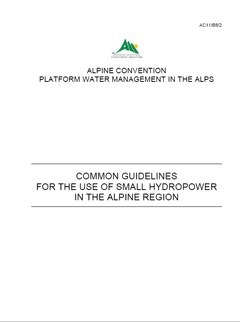Publications
Common guidelines for the use of small hydropower in the alpine region
| Year of publication | 2011 |
|---|---|
| Publisher(s) | Ständiges Sekretariat der Alpenkonvention Website: http://www.alpenkonvention.org |
| Place of publication | Innsbruck |
| Language | en |
| Price | free |
| Purchase | |
| Page(s) | 71 |
| Publication type | Other |
Based on the Mandate from the Xth Ministerial Conference of the Alpine Conference in Evian, March 2009 and referring to the Climate Action Plan approved at the Xth Ministerial Conference of the Alpine Conference in Evian, March 2009, the Platform Water Management in the Alps (PWA) has worked out common guidelines on the use of small hydropower including good practice examples.
The guidelines on the use of small hydropower include common principles and recommendations, an outline for an assessment procedure as well as a pool of evaluation criteria. However, no concrete methodology is proposed since sufficient flexibility for implementation of the guidelines is needed in order to pay attention to regional differences and varying national boundary conditions. To underpin the guidelines, Good Practice Examples with concrete methodologies are presented in Annex 1.
The common guidelines have to be considered along with the existing national/regional legal frameworks and instruments. To that end, Annex 2 provides a compilation of links to national and regional guidance documents.
As guidelines they have the character of recommendations but do not exert any legally binding force.
The guidelines on the use of small hydropower include common principles and recommendations, an outline for an assessment procedure as well as a pool of evaluation criteria. However, no concrete methodology is proposed since sufficient flexibility for implementation of the guidelines is needed in order to pay attention to regional differences and varying national boundary conditions. To underpin the guidelines, Good Practice Examples with concrete methodologies are presented in Annex 1.
The common guidelines have to be considered along with the existing national/regional legal frameworks and instruments. To that end, Annex 2 provides a compilation of links to national and regional guidance documents.
As guidelines they have the character of recommendations but do not exert any legally binding force.


